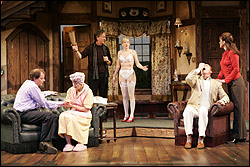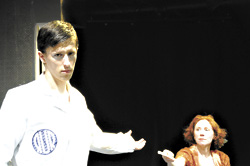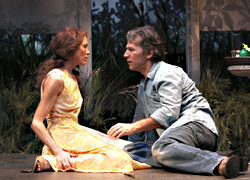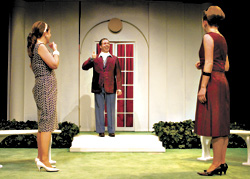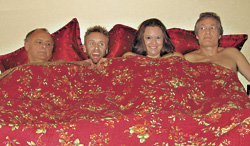Marx famously said that history repeats itself, first as tragedy, second as farce. Great farce repeats itself, sometimes tragically, but always as a matter of form. At its old-fashioned best, farce has the sublime capacity to amaze us through the repetition that can unleash a comic tsunami of miscommunication, misattribution, and mistaken identity. The history is just there to be turned inside out and over again.
The plot of Noises Off (Seattle Repertory Theatre, 206-443-2222; ends Sat., Jan. 15) is about as interesting as an unsalted omelet, but that’s OK. Playwright Michael Frayn makes sure all the usual suspects are present and accounted for as the scene opens on the disastrous, last-minute dress rehearsal for a saucy romantic comedy called Nothing On. Here we have the abusive, put-out director, Lloyd Dallas (Mark Chamberlin); the over-the-hill actress Dotty Otley (Lori Larsen), a dead ringer for Bette Davis; the preening, inarticulate lead, Garry LeJeune (Bradford Farwell); the autistically ditzy blonde, Brooke Ashton (Bhama Roget), who takes literal-mindedness to pathological levels; the ascotted, querulous Frederick Fellowes (Michael Patten), a browbeaten hypochondriac whose wife just walked out on him; the old drunk, Selsdon Mowbray (Clayton Corzatte); the tough-minded actress Belinda Blair (Suzanne Bouchard); and a pair of stage managers, goofy Tim Allgood (Mark Anders) and Poppy Norton-Taylor (Stephanie Timm), a mousy girl prone to quick tears.
The setup, then, is classic romantic farce, with the added twist of mirroring and layering as the play On reflects and distorts the workings of the play Off. In On, we have a pair of couples, each unaware of the other, arriving at a romantic getaway for a surreptitious fling. Off has its own share of entanglements and affairs: Garry and Dotty, Lloyd and Brooke, Lloyd and Poppy, etc. The idea in all this reflexivity is to strip away the artifice of farce while simultaneously deepening the farcical workings of so-called “real” life. Of course, it’s all just a play, so there’s that, too. But all that really matters is whether it pays off in the end—whether we fall, once again, for the knockdown.
The first act moves slowly, almost too slowly, painstakingly priming the pump for absurdity. Yet, director Richard Seyd works it perfectly, setting the traps with expert pacing and refusing to tip his hand. When the curtain rises on the second act, everything has been flipped 180 degrees. This backstage set, with the On action facing away, is gorgeously designed. Even more astonishing is the controlled chaos that ensues as we see On unfold once again, with “onstage” becoming “offstage” and vice versa. It’s a divinely orchestrated representation of a theatrical fiasco, each actor hitting the mark in a delicately balanced dance of movement, gesture, and dialogue, with our laughter inspired as much by gratitude and delight as anything else.
Why not flip the stage and go one more time? With the stage facing front again, the third go-through of Nothing On substitutes disintegration for madness as the company, at the end of the run, collapses in a heap of sexual and artistic confusion. Though hardly as hilarious as the previous act, Act III achieves a kind of exhausted euphoria: Familiar now with the play-within-the-play as well as the players, we see each comic element given a final yank, forcing the actors to “improvise” and stumblingly overcome each obstacle thrown in their path. Things can’t get worse, and the worst rarely looks so fine. Farwell’s exhilarating pratfall near the end is a grace note of sorts, an endearing surrender to fate— totally untragic, entirely farcical.
